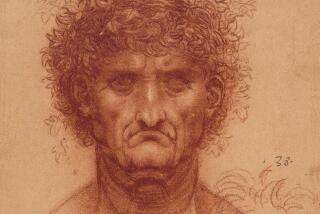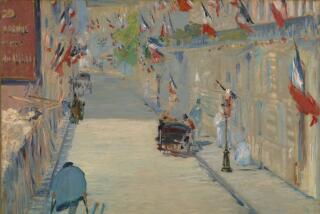A DAY IN THE COUNTRY, ITALIAN STYLE
- Share via
“The Macchiaioli: Painters of Italian Life, 1850-1900,” at UCLA’s Wight Art Gallery, is an exhibition made in art historians’ heaven. Serious and pretty, surprising and soothing, relevant in terms of aesthetics, sociology and politics, the show has all the elements required to make it critically provocative and popularly successful.
First, there’s UCLA’s coup of unearthing a significant school of art so little known that it’s a struggle to pronounce its name: Mahk-ya-yo-ly. Working with the Macchiaioli Archive in Rome and Florence, Wight Gallery Director Edith Tonelli has launched the first extensive presentation of this material in the United States. She and her colleagues have culled 164 paintings from 25 collections--24 Italian and one American--for a survey enhanced by audio-visual materials and a scholarly catalogue.
Second, there’s the inevitable comparison of the Macchiaioli with the relentlessly popular French Impressionists, a parallel that guarantees an appreciative audience. Though the Italians were overshadowed by the French, the two groups worked about the same time, concerned themselves with natural light and rebelled against the spit and polish of academic art by painting loosely and directly from nature.
Many people will take the exhibition no deeper than this and have a fine time of it. But considering the Macchiaioli “Italian Impressionists” is so superficial and inadequate an approach that it’s no wonder the catalogue essayists fill several pages with protestations. Their arguments are enlightening, but it doesn’t take an expert to see the difference.
Impressionism seems perennially young, lush and verdant; the relatively dry and aged Macchiaioli work preceded it by a decade. If the quintessential Impressionist canvas appears to have been created in June, its Italian counterpart was painted in late August. The Impressionists’ vivid greens and spring pastels are often supplanted by the yellow browns of early autumn.
Influenced by Barbizon painters, both engaged their entire surfaces in a play of light, but the Impressionists inclined toward flickering, broken color while the Macchiaioli favored blocks of color and solid images. And there’s a subtler divergence: The quality of ever-changing light fascinated the French, while the Italians froze fleeting moments that typified what was constant in their surroundings.
Like the Impressionists, the Macchiaioli got their name--and wore it as a badge of honor--from a critic who derided their splotchy use of color. Macchia (variously translated to mean a stain, spot, or a thorny patch of woods) had been widely used as artists’ shorthand, but the Macchiaioli developed the method as a means of preserving spontaneity. Insisting that finishing should only heighten the first impression, they saw theIr “splotcheS” not as preparatory sketches but as the nucleus of an experience.
Artists of both schools broadened their brush strokes as they trooped off to the country in their respective rebellions, but there’s a profound difference in their attitudes and even their subject matter. The Impressionists were urban aesthetes who painted bourgeois vacationers and technological phenomena. The comparatively provincial Macchiaioli, based in Tuscany, were political and social activists. They identified with lower classes and engaged in the struggle to throw off Austrian rule, unite Italy and revive its moribund culture.
Early in the movement, the Macchiaioli painted battle scenes and propagandistic tracts for the Risorgimento, the “renaissance” movement intent on unifying Italy. They aired their dissent at the Caffe Michelangiolo in Florence, and some of them actually participated in military combat. Later, when a Macchiaioli artist spent a day in the country or joined his peers at a rural retreat, he was more likely to paint hard-working peasants than picnicking city folk. And he might illuminate such troublesome issues as illiteracy and women’s rights.
This pleasant show of benign-looking paintings actually contains some loaded images: Telemaco Signorini’s depressing view of women in an insane asylum and his sympathetic look at prostitutes (the latter painting kept hidden in his studio); Adriano Cecioni’s and Odoardo Borrani’s depictions of women sewing red shirts for Garibaldi’s soldiers; Borrani’s painting of a woman writing a letter for her illiterate servant.
The exhibition’s predominantly pastoral tone shifts dramatically in the early military paintings and near the end, where we find Giovanni Fattori painting burly cowboy pictures that give new meaning to spaghetti Westerns. Between these two eruptions of action rolls an undulating plain of genre scenes, panoramas and portraits.
Aesthetic highs arrive in key paintings that reveal the inventiveness and virtuosity of the movement, such as Raffaello Sernesi’s bold and sure reduction of “Rooftops in the Sunlight” and Silvestro Lega’s “The Trellis,” a consummate expression of communal warmth and rural dignity.
Relatively modest evidence of genius presents itself repeatedly: in Fattori’s small horizontal compositions that sum up a landscape with astonishingly concise sensitivity; in Lega’s touching picture of a dying Giuseppe Massini, a leader of the struggle for unity; in Giovanni Costa’s 1862 “Portrait of a Young Boy,” which typifies the Macchiaioli preference for forthright expressions.
Though not entirely immune to sweet little kids and sappy lovers, the Macchiaioli eliminated most of the sentiment that oozes through 19th-Century painting. If their art can’t be separated from its social and historical context, neither can it be divorced from a widespread push toward modernism.
The Macchiaioli replaced their predecessors’ detached views--typically bought as expensive, outsized post cards by tourists--with scenes that bring the viewer into the painting. They painted real people in bustling city streets, engaged in quiet chores at home or laboring in fields. Though they documented an era of conflict followed by disenchantment, the Macchiaioli were primarily painters who wanted to speak for their time and preserve its spontaneity.
Were they as successful as the Impressionists? Absolutely not.
The French Impressionists’ concept of light as an energetic field of motion led to a revolutionary way of seeing and paved the way to international Modernism. The Macchiaioli were far more confined to their region, but they were the most progressive painters in late 19th-Century Italy and their work deserves its belated exposure.
Dario Durbe, director of the Macchiaioli Archive in Rome, sums up the situation with refreshing candor: “In the midst of the luxuriant vegetation of Impressionism . . . the Macchiaioli appear to us today as mere wildflowers, blooming among the imposing ruins of a lost civilization, and yet still capable of surprising, impressing, and delighting. . . .”
More to Read
The biggest entertainment stories
Get our big stories about Hollywood, film, television, music, arts, culture and more right in your inbox as soon as they publish.
You may occasionally receive promotional content from the Los Angeles Times.










